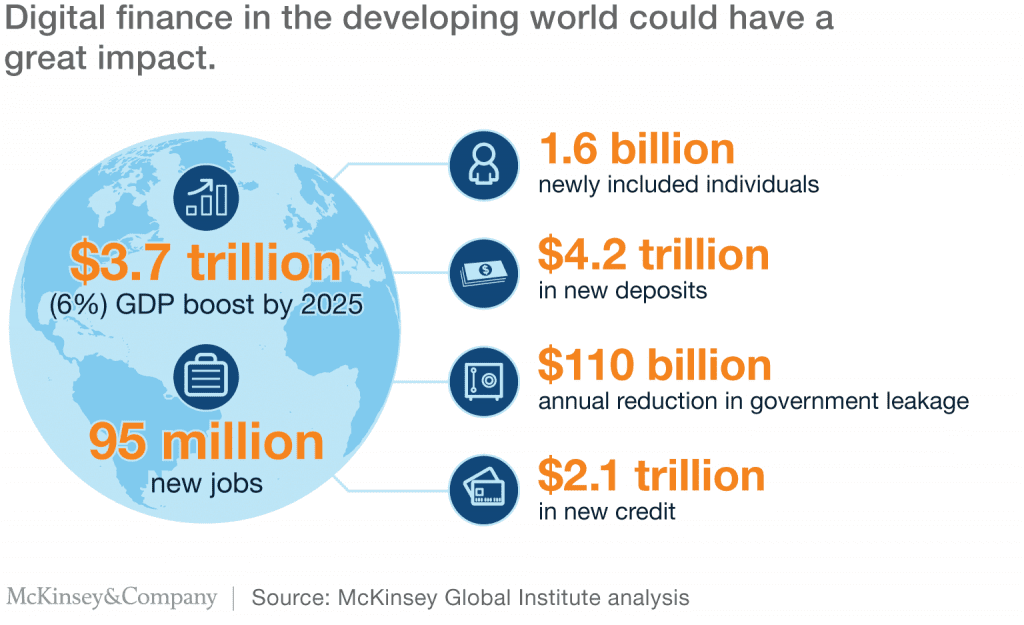
FinTech’s are innovating at every step in the financial industry and have brought a new standard to the design and implementation strategies for financial inclusion. Thanks to these innovative ideas, implemented in digital financial offerings, many of the 2 billion people without banking services worldwide have access to essential financial products. A concept that has been called FinTech for good.
Financial inclusion aims to improve people life by providing and put an effort to make financial products and services accessible and affordable to every individual and businesses, regardless of their income or company size. These groups are often unbanked or underbanked. It focuses on providing financial solutions to the economically deprived. It also describes the provision of savings and loan services to the poor in an inexpensive and easy-to-use form, and aims to ensure that the poor and marginalised make the best use of their money and attain financial education.
“Financial access facilitates day-to-day living, and helps families and businesses plan for everything from long-term goals to unexpected emergencies. As account holders, people are more likely to use other financial services, such as credit and insurance, to start and expand businesses, invest in education or health, manage risk, and weather financial shocks, which can improve the overall quality of their lives,” it was stated by World Bank. That is why is so important the deployment of fintech for good in these regions of the world.
The World Bank Group, which includes both the World Bank and the International Finance Corporation, is also sponsoring an initiative called Universal Financial Access 2020, the goal of which is to ensure that by the year 2020, an additional 1 billion adults will “have access to a transaction account to store money, send and receive payments as the basic building block to manage their financial lives.”
Why Financial Inclusion is Important?
Financial inclusion is essential for all those world’s poor population which is working in the informal sector for all individuals who:
· Don’t have a secure place to save money
· Don’t have access to small loans or credit lines and can fall prey to corrupt lenders;
· Can’t build a credit record
· Have no way to receive money including customer payments or remittances from relatives working abroad
· Have no safe, reliable and easy way to make payments, such as to suppliers, schools or doctors.
These people are, effectively, “financially excluded.” Most of the unbanked live in developing countries and more than half are women.
World Bank Group mentioned, “Without inclusive financial systems, individuals are limited in their ability to absorb economic shocks, smooth consumption, and invest in education or entrepreneurial activities.” What’s more, it adds, “Financial inclusion can have beneficial impacts on managing income shocks, food security, efficient targeting of social transfers, and access to services.”
The inclusion helps individuals to make daily payments reliably. It helps them to access credit which can be invested in their small-scale income-generating activities. It also helps people save their cash so that they can make future investments or respond to unforeseeable risks. Financial inclusion improves access to insurance products and services which are critical towards addressing vulnerabilities in any type of business.
“Access to financial services opens doors for families, allowing them to smooth out consumption and invest in their futures through education and health. Access to credit enables businesses to expand, creating jobs and reducing inequality. Financial inclusion is the bridge between economic opportunity and outcome,” it was stated by IMF.

Role of FinTech in Financial Inclusion
The financial industry is rising with new innovations to provide products and services to the global population, and often make profit in the process. FinTech’s are innovating at every step and have brought a new standard to the design and implementation strategies for financial inclusion. For example, smartphones for mobile banking cloud computing, big data analytics, artificial intelligence and blockchain are making it possible for anyone to access financial products and services for the first time, wherever they are and whenever they need them, in a faster, cheaper, more transparent and efficient way than traditional banking. It is providing more innovative tools to address the problem of inaccessibility to financial services and devised new ways for individuals and organizations to obtain the services they need at reasonable costs.
With advances in financial technology and digital transactions, more and more start-ups are now making financial inclusion simpler to achieve. However, the World Bank estimates that some 1.7 billion adults worldwide still lack access to even a basic bank account. The growth of fintech and the increasing adoption of digital financial services by consumers introduces new opportunities to increase access to financial services. They are improving the customer experience of financial services and accelerating use and engagement. They are also building the groundwork including easier digital identity verification, collaborative customer due diligence, data sharing, and payment schemes that can catalyse a host of financial services. FinTech solutions are expected to reduce operating costs, making it profitable for providers to serve a larger range of customers.
Implementation of effective regulation helps achieve a strong financial system. In the framework of financial inclusion, effective regulation helps ensure that growing financial use and access is done in a manner that does not entail harm to financial stability.
Fintech can potentially contribute to both financial stability and financial inclusion. On the one hand, fintech is leading to new, more efficient and more accessible delivery channels for financial products and services. The wider objective of FinTech is to serve the unmet financial needs of those parts of the population which are not the core target segments of traditional financial services models.
FinTech’s potentially enhance financial services for underbanked people in the following ways
Better experience: Some FinTech’s offer services and applications that improve how customers experience financial services, increase their use, and increase trust and customer engagement. These services may be offered on smartphone apps or they may use simple SMS conversations to observe behaviour, offer advice, or provide an interactive option for customers to resolve complaints.
Improved products: Other FintTch’s improve financial services, such as credit, insurance, and pensions, by introducing digital features or creating operational efficiencies that could bring greater access and affordability for the end consumer. In the process, they often collect better data, which creates more options to further improve products.
New value propositions: Some FinTech’s explore how they can combine improvements in products and experience to offer entirely new value propositions to underserved customers. These services might offer flexibility and customization that was not available before; they could also offer new and different solutions that address specific financial challenges experienced by low-income customers.

Simon Pearson is an independent financial innovation, fintech, asset management, investment trading researcher and writer in the website blog simonpearson.net.
Simon Pearson is finishing his new book Financial Innovation 360. In this upcoming book, he describes the 360 impact of financial innovation and Fintech in the financial world. The book researches how the 4IR digital transformation revolution is changing the financial industry with mobile APP new payment solutions, AI chatbots and data learning, open APIs, blockchain digital assets new possibilities and 5G technologies among others. These technologies are changing the face of finance, trading and investment industries in building a new financial digital ID driven world of value.
Simon Pearson believes that as a result of the emerging innovation we will have increasing disruption and different velocities in financial services. Financial clubs and communities will lead the new emergent financial markets. The upcoming emergence of a financial ecosystem interlinked and divided at the same time by geopolitics will create increasing digital-driven value, new emerging community fintech club banks, stock exchanges creating elite ecosystems, trading houses having to become schools of investment and trading. Simon Pearson believes particular in continuous learning, education and close digital and offline clubs driving the world financial ecosystem and economy divided in increasing digital velocities and geopolitics/populism as at the same time the world population gets older and countries, central banks face the biggest challenge with the present and future of money and finance.
Simon Pearson has studied financial markets for over 20 years and is particularly interested in how to use research, education and digital innovation tools to increase value creation and preservation of wealth and at the same time create value. He trades and invests and loves to learn and look at trends and best ways to innovate in financial markets 360.
Simon Pearson is a prolific writer of articles and research for a variety of organisations including the hedgethink.com. He has a Medium profile, is on twitter https://twitter.com/simonpearson
Simon Pearson writing generally takes two forms – opinion pieces and research papers. His first book Financial Innovation 360 will come in 2020.



































